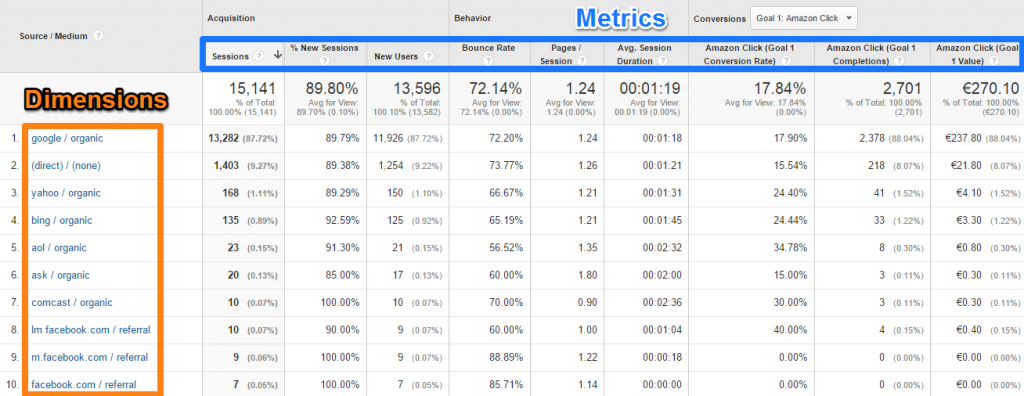Grasping the 'Secondary Dimension' in Google Analytics: Full Summary
Wiki Article
Decoding the Value of Additional Measurement in Google Analytics: All Regarding Its Importance and Impact
In the world of electronic analytics, the utilization of additional measurements within Google Analytics offers as a critical device for discerning much deeper layers of information understandings. The significance of secondary dimensions lies in their capability to provide a nuanced view of individual behavior and communication with a web site or system.Comprehending Additional Dimensions in Google Analytics
The understanding of secondary dimensions in Google Analytics is necessary for obtaining much deeper insights right into individual behavior and web site performance. While primary measurements provide essential data factors such as website traffic resources and page views, secondary measurements permit a much more nuanced analysis by offering extra context to these main metrics. By including additional dimensions, individuals can sector and filter their information to uncover patterns and patterns that may not be quickly apparent.
Revealing the Benefits of Second Measurements
Structure upon the foundational understanding of second measurements in Google Analytics, exploring the advantages they supply discloses very useful insights for enhancing data evaluation and decision-making. By incorporating second measurements, individuals can delve deeper into their data, obtaining an extra comprehensive sight of customer actions, material efficiency, and other key metrics.Furthermore, additional measurements offer context to primary information, supplying extra layers of info that can help in comprehending user interactions and preferences. This enhanced understanding can direct critical decision-making, leading to even more targeted advertising and marketing projects, website optimizations, and overall enhanced performance. In significance, secondary dimensions work as an effective device for unlocking deeper insights and optimizing the energy of Google Analytics for services and website proprietors.
Leveraging Second Dimensions for Enhanced Insights
By using the power of additional measurements in Google Analytics, businesses can uncover much deeper insights that drive educated decision-making and strategic optimization initiatives. Leveraging secondary dimensions allows organizations to dig past surface-level information and acquire an extra comprehensive understanding of individual behavior, target market demographics, website traffic resources, and internet site performance. By combining main measurements like website traffic resources with second measurements such as geographical area or device classification, companies can determine which tools or areas are driving the most important traffic to their internet site.Furthermore, second measurements enable services to segment and evaluate data much more effectively, helping them recognize patterns, patterns, and opportunities check my site that may have or else gone unnoticed. By making use of second dimensions, businesses can tailor their advertising techniques, material, and individual experience to better meet the needs and preferences of their target audience. In essence, leveraging secondary measurements in Google Analytics encourages services to make data-driven decisions that lead to boosted performance, raised ROI, and lasting development.

Effect of Second Measurements on Information Analysis
Enhancing information analysis through the usage of second dimensions in Google Analytics gives organizations with a deeper understanding of their online efficiency metrics. By including secondary measurements, such as time of day, geographical place, or device classification, services can discover beneficial insights that might have been forgotten with primary measurements alone. This boosted level of granularity enables even more specific segmentation of data, making it possible for organizations to determine patterns, fads, and correlations that can drive critical decision-making.
Making The Most Of Prospective: Additional Dimensions Methods
One key method is to incorporate additional measurements with key measurements to acquire a detailed view of user interactions. Coupling the primary measurement of 'source/medium' with second measurements like 'touchdown web page' or 'device category' can expose which channels are driving web traffic to certain pages or just how individual behavior varies across devices.Moreover, utilizing second dimensions to section information based on individual demographics, habits, or technology can aid organizations customize their marketing initiatives to details target market sections. This targeted method can result in enhanced conversion rates, improved user experiences, and inevitably, raised ROI. By making the most of the potential of moved here additional measurements in Google Analytics, businesses can make enlightened choices, enhance their on the internet presence, and drive lasting growth.
Verdict
In conclusion, second dimensions in Google Analytics play a critical function in providing deeper understandings and enhancing data analysis. Integrating secondary dimensions into data evaluation techniques can lead to more informed decision-making and boosted total performance.While key measurements supply fundamental information factors such as traffic sources and page views, second dimensions allow for a much more nuanced analysis by giving extra context to these main metrics. By integrating main measurements like web traffic resources with additional measurements such as geographic area or device classification, businesses can recognize which areas or devices are driving the most important traffic to their site.
By including second dimensions, such as time of day, geographical location, or tool group, services can uncover beneficial understandings that may have been neglected with main measurements alone. One key technique is to integrate second measurements with primary dimensions to gain a thorough sight of user communications. Pairing the primary dimension of 'source/medium' with secondary measurements like 'landing web page' or 'device category' can expose which networks are driving web traffic to specific web pages or how user actions varies throughout gadgets.
Report this wiki page